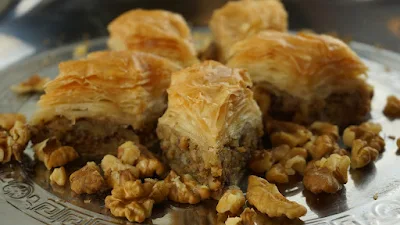The baklava are one of the culinary heights of the Orient. They can be found in the Balkans, in Turkey, the Middle East and India, under different names and recipes but essentially the same: phyllo pastry alternated with nuts.
Currently they are also available in any country thanks to the action of emigrants or simply because they have started to be produced locally.
Its origin is the subject of discussion. The classical theory places its origin in Arab cuisine - in fact the name is Arabic - but another trend that has recently gained great strength indicates a Turkish origin. The truth is that it is not a complex recipe that could well have arisen in many places simultaneously.
Cooking baklava is very simple if we have phyllo pasta (frozen or fresh). Otherwise it can be quite difficult to make phyllo dough at home. I highly recommend getting phyllo pastry and above all NEVER substitute it for this recipe with shortcrust pastry or puff pastry. Baklava made without phyllo is not baklava, nor is it like it.
INGREDIENTS :
- 400 grams (14 oz) of phyllo pastry (approximately 24 sheets)
- 2 tablespoons of sugar
- 200 grams (7 oz) unsalttered butter
- 250 grams (9 oz) of nuts (for example pistachios, walnuts etc)
- Ground cinnamon (optional)
- Orange blossom water (optional)
The first thing to do is clarify the butter. To do this, we melt the unsalted butter over low heat and let it rest for about five minutes, long enough for three layers to form. The upper one is foam that we will remove with a slotted spoon. The following is the layer that we are interested in preserving and that we will separate by simple decantation. At the bottom we will have a whitish substance that is the whey that we will reject without further ado.
In the event that we have purchased frozen phyllo dough, we will have previously defrosted it in the refrigerator, never out of it to prevent the sheets from sticking together and becoming unusable.
Now we are going to make the filling. There are two ways to do it. The simple one that I recommend is to mix some chopped nuts - pistachios and walnuts - with the two tablespoons of sugar. The most complex is to prepare a mixture with a tablespoon of orange blossom water, nuts, cinnamon powder and sugar. This mixture presents the problem that it is not advisable to make a wet filling with phyllo dough. In fact, it is totally inadvisable and before using the second version of the filling you should dry it on absorbent paper. There would still be a third way to make the filling by simply chopping the nuts, letting the syrup that we will then prepare be the one to provide the sweetness. If you are not going to use syrup there is no other choice but to incorporate the sugar with the filling. Since I am going to use syrup, I will simply chop the pistachios with the walnuts.
Now we are going to paint the bottom of a tray that can be baked in the oven with clarified butter. On this background we will deposit two sheets of filo dough and we will paint with butter again. Then another two and paint again, and so on until we have used 12 sheets (half of the available ones). We evenly sprinkle the nuts until the entire surface is covered and we alternate two filo sheets with a clarified butter coating until we finish with all the available filo dough. The top layer will obviously also need to be painted to make it golden when baking. We will cut the block with a very sharp knife to give the baklava the shape we want, whether they are triangles or squares the size of a bite.
To bake we preheat the oven to 220 degrees (428 F) and keep the baklava for 10 minutes. Then we lower it to 180 degrees (356 F) and finish baking to get a crisp and golden brown without the annoying "crumbling" of the puff pastry.
Let cool and separate according to the cuts we have made before putting in the oven. As we have not added sugar to the filling we will have to make syrup.
INGREDIENTS FOR THE SYRUP:
- 1 cup of sugar
- Half cup water
- 1 tablespoon orange blossom water
- Juice of half a lemon
You can make orange blossom water simply by buying the orange blossom flowers at the herbalist and boiling them in water, although it is usually easy to find in pastry shops. Rose water works too.
Put the water in a saucepan with the sugar and over medium heat until it boils. Boil for 10 minutes, stirring the foam as it appears (they are impurities that cloud the syrup). Lemon juice is added and simmered for another ten minutes. At the end the orange blossom water is added. It is important to cover the saucepan because otherwise the water would evaporate and we would make caramel, not syrup. Baklava that are obviously "unsugared" are bathed with this warm syrup and ready to serve.
I highly recommend this recipe, it is one of the summits of world gastronomy and I am not exaggerating.

